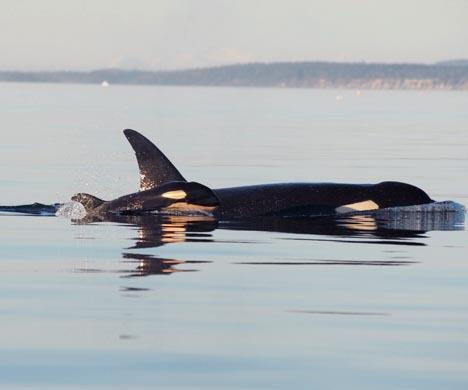The Center for Whale Research has confirmed the birth of a new L pod calf.
The new calf was photographed with its pod on Feb. 21 in Cordova Bay. The birth brings the Southern resident orca population up to 89, its highest in five years.
The Center for Whale Research posted this report on the Orca Network Web site:
“After receiving a report from Mark Malleson of L’s heading south along the Vancouver Island shoreline, Ken Balcomb and Dave Ellifrit of the Center for Whale Research launched Starlet in Roche Harbor around 1530 and arrived on scene at 1610. The L12 subpod was traveling slowly south in Cordova Bay. Both L94 and L77 were traveling with calves and we were able to confirm that L113 was L94’s calf. L77’s calf (L114) was very young and still had fetal folds.
Around 1700 near the south end of Cordova Bay, the L12s turned east and spread out and began foraging. Lots of taillobs, cartwheels and pec slaps out of L79, L85, and L89. L89 also breached twice and whales up ahead of us looked to be going after some fish. We left the whales at 1711 still spread out and heading east. Whales photographed were L12, L22, L25, L41, L77 and L114, L94 and L113, L79, L85, and L89.
See photos on the Center for Whale Research Web site
The three Southern resident pods — called “residents” because they spend a majority of the year here — are considered endangered by the U.S. and Canada. Their population, believed to have been historically in the high 100s, was decimated by captures for marine parks, which ended in the 1970s, followed by pollution and declining salmon populations.
The whales’ population plummeted to 71 by 1973, climbed to 99 in 1995, then plummeted to 79 six years later. The population rebounded to 80 in 2002, 83 in 2003, 85 in 2004 and 89 in 2005, and has seesawed around 88 since then. The whales were declared endangered by the U.S. and Canada by 2005.
The National Marine Fisheries Service is writing a recovery plan for the whales. The most controversial proposed element of the recovery plan is banning boats from the west side of San Juan Island from May 1 to Sept. 30.
That no-go zone is opposed by local officials, as well as kayakers and kayak tour operators. They say that kayaks are no-impact vessels, and that a no-go zone would have a dramatic economic impact on the local economy.
In a column published in The Journal and on SanJuanJournal.com, Dr. Val Veirs and Jenny Atkinson of The Whale Museum proposed a go-slow zone for all vessels, with special consideration given for human-powered craft such as kayaks.
The federal government accepted public comments until Jan. 15.
Balcomb believes the key to orca recovery is food.
“I told the government that for 20 years the population is going to go up and down like this,” Balcomb said in an earlier interview. “The long-term solution to an upswing here is fish. We need to get the chinook restored. The way it’s going, if there’s not enough fish, you can have a baby but it’s not going to survive.”
The center’s Web site states, “The whales are traveling as far as California and Haida Gwaii (Queen Charlotte Islands) searching for these nutritious fish, but they keep coming back to the Salish Sea. If the whales could talk to us, they would probably say that our effort to promote wild salmon recovery in the Pacific Northwest is good for all of us, so let’s do all that we can. And, let’s clean up the pollution, too, so we can all eat healthy fish.”
The Center for Whale Research and others also blame marine pollution and acoustic impacts from dredging, seismic testing and military sonar for the decline in the population.
To hear what sonar sounds like underwater, CLICK HERE.




